Ionia › The Maya Calendar and the End of the World » Ancient origins
Articles and Definitions › Contents
- Ionia › Ancient History
- The Maya Calendar and the End of the World: Why the one does not substantiate › Antique Origins
Ancient civilizations › Historical and archaeological sites
Ionia › Ancient History
Definition and Origins
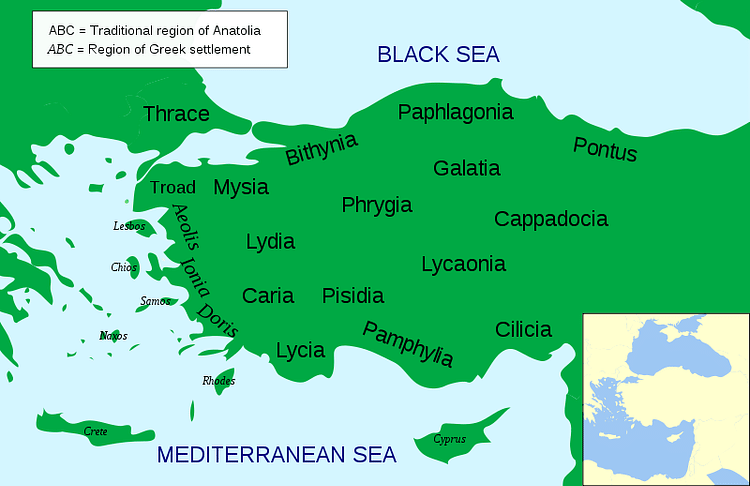
Ionia is the name given during ancient times to the central region of Anatolia ’s Aegean shore in Asia Minor, present-day Turkey, one of the most important centres of the Greek world. Here the Greeks founded a dozen mini-states, two of them on the offshore islands of Chios and Samos, the rest of them stretching along the strip of mountainous coastland. During the 6th century BCE, Ionia became the focus of the intellectual life of Greece, a period known as the “Ionian awakening”, a name for the initial phase of classical Greek civilization.
Using the sea as a highway, which was much cheaper, faster, and more efficient than transport by land, the Greeks expanded and developed in a such a way that conflict with a major power became inevitable. The Greco-Italian-Sicilian trading route that the Greeks controlled competed more and more with the Oriental Indo-Persian-Phoenician and this commercial rivalry set the stage for war. Ionia was the initial setting of the Greco- Persian wars.
ORIGIN OF IONIA
Ionia was colonized by Greeks from the Athens region around 1000 BCE. The commercial activity in Ionia was in competition with the Phoenicians, who were the leaders of sea-trade at that time. However, some important changes took place on the eastern shore of the Mediterranean during the 8th century BCE: Assyria renewed their strength like never before, and the Phoenician city -states were conquered. The Phoenician sea-trade withered, and the Greek city-states took advantage of the Phoenician subjection to Assyria and gradually turned into the leading sea-traders and navigators. Some Phoenician colonies in the west remained independent, and the only serious competition the Greeks came across was from the expanding power of Carthage.
IONIAN INTELLECTUALS WERE NOT HEAVILY INFLUENCED BY RELIGION NOR LIMITED BY ANCIENT BOOKS CLAIMING TRUTH OR DIVINE REVELATION.
During the following centuries, Ionian cities underwent important changes. Political and economic power, which used to be concentrated in the hands of the landowning aristocracy, gradually moved to the merchant class. Ionian merchants established colonies as trading posts in Egypt, Italy, and along the Black Sea. Miletus alone, the southernmost Ionian city, had about 80 colonies and became the richest city in the Greek world. The wealth and luxury of the city was proverbial throughout Greece.Milesian merchants had such levels of profits that they lent money to a number of enterprises and even to the municipality itself.
IONIAN INTELLECTUAL LIFE
To the east of the Ionian city-states lay the Kingdom of Lydia. Ionians and Lydians remained on peaceful terms, with very tight cultural and commercial relations. The city of Sardis, Lydia's capital, was an important centre for the traffic of goods and ideas between Mesopotamia and the Greek Ionian settlements. Beliefs, customs, and knowledge, in addition to commercial goods, were constantly circulating in Sardis.
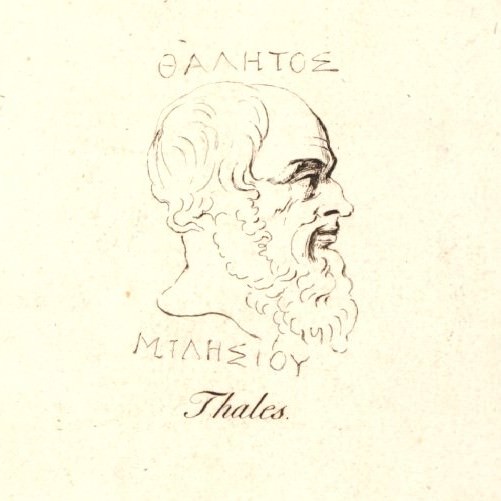
Thales of Miletus
By the time when Ionian cities became the intellectual leaders of Greece in the 6th century BCE, the city of Miletus became the focus of an intellectual revolution. In this city the power was in the hands of merchants and the priesthood had no significant social impact. Ionian intellectuals were not heavily influenced by religion nor limited by ancient books claiming truth or divine revelation. Even Homeric poems had hardly taken any definite form yet. Milesians were used to travelling to distant regions and received the input of the civilizations of Lydia, Babylon, Phoenicia, and Egypt. Mathematical knowledge, foreign commerce and geography, astronomy, navigational techniques, all these notions helped to enrich Miletus. Meanwhile, wealth had created leisure, and freedom of thought was widely accepted. All these factors can help to understand how a number of Ionian minds developed the idea that the world could be understood in terms of physical phenomena, without reference to myths or superstitions. The revolutionary idea of replacing supernatural explanations with the concept of a universe that is governed by laws of nature began in Miletus, with a man named Thales.
Thales of Miletus is credited as the author of a revolutionary hypothesis concerning the fundamental structure of the universe by claiming that water was the original substance of the universe. He is famous for his astronomical knowledge that allowed him to predict a total eclipse of the sun and also for his knowledge on geometry, which he brought from his visit in Egypt. This new rational insight influenced other Ionians thinkers such as Anaximander and Anaximenes, who also continued this rationalistic tradition. In many cases their ideas led to conclusions surprisingly similar to what our more sophisticated methods have led us to believe today. In Ionia we find the roots of the Western scientific tradition.
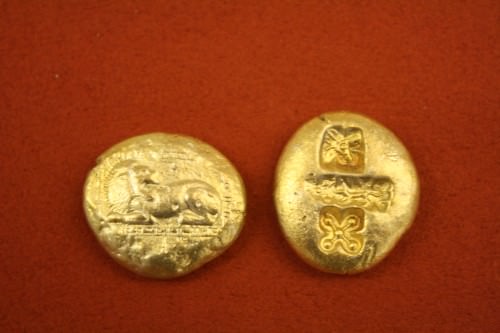
Miletos Electrum Stater
PERSIAN CONTROL & REVOLT
The political map of this region started to change around 612 BCE. The Assyrian Empire came to an end as a result of the destruction of Nineveh, its capital, the most powerful city in the world at that time. An allied army of Persians, Medes, Chaldeans, and Babylonians besieged and sacked the centre of Assyrian power. This left Babylon as the imperial centre of Mesopotamia and Lydia was now free to turn its attention to the West. The Ionian cities were now dominated by Lydia, but Lydian rulers admired the Greeks and treated the Ionian cities leniently. Croesus, the last Lydian king, even paid for the construction of the Temple of Artemis, which became one of the Seven Wonders of the Ancient World. Soon after, Persiabecame the dominant power of Mesopotamia, putting an end to the Babylonian supremacy. In 546 BCE, the Persian king Cyrus II defeated Croesus and Lydia, which along with the Ionian cities, became controlled by the Persians.
About 500 BCE, the Ionian cities under Persian control dismissed the Persian authorities and declared their independence, triggering the Ionian revolt, the first of the many military conflicts between Greeks and Persians. Miletus was the leading state and Athens sent a fleet of 20 ships to support the revolt. Each Ionian rebel state raised its own troops but kept them under separate command. The army of Miletus marched upon Sardis and burned it to the ground.
In 494 BCE, the Ionian cities organized a united fleet that engaged the Persian navy at Lade in one of the most important sea battles of history. Just before the battle began, about 50 ships belonging to the navy of the Ionian city of Samos sailed away due to a secret arrangment they had with the Persians. Many other contingents following their disloyal example. The Ionian defeat was complete and Ionian civilization never managed to fully recover from this disaster.
The Persians captured Miletus, all the males were killed, the women and children enslaved, and from that day the city became a minor town. Persian control was re-established throughout Ionia until the decisive Greek victory at the Battle of Salamis (480 BCE), when the Ionian cities regained their independence and helped to form the Delian League with Athens.
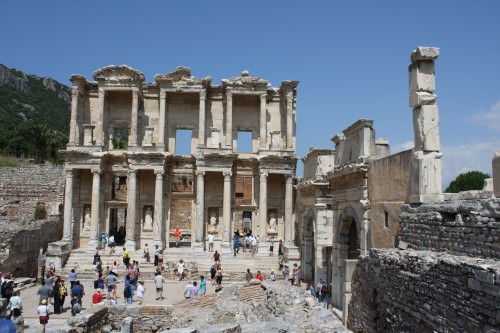
Celsus Library, Ephesos
HELLENISTIC PERIOD, SELEUCID CONTROL, & ROMAN CONTROL
Around 334 BCE, Alexander the Great marched down into Ionia, offering the Greek cities democratic self-governance under his protectorate. Most cities opened their gates without resistance and enjoyed a new era of prosperity during the Hellenisticperiod, but none of them restored their previous splendour. Miletus refused Alexander ’s offer and was finally levelled after a long siege and was never restored to its previous status as a leading city. The region then became part of the Seleucid, and later of the Attalid, Kingdom.
About 130 BCE Ionia came under Roman control and became part of the Roman province of Asia. This new period allowed many of the Ionian cities to recover some of their lost success. The archaeological record in Miletus suggests that the population reached a new peak, which is hard to estimate, although some scholars suggest a figure of 7000 or 8000. Smyrna and Chios were also considered important cities. Major monuments were expensively refurbished in the city of Ephesusduring the 4th century CE, including the stadium, the theatre and the harbour baths. Today, the site of Ephesus is considered a very valuable example of classical urbanism.
The Maya Calendar and the End of the World: Why the one does not substantiate › Antique Origins
Ancient Civilizations
The Popol Vuh recounts the story of twins who journeyed to Xibalba. For the Maya, their round of adventures serves as a metaphor for timeless, repeating cycles and for the regeneration of earth and all living things. – Gene S. Stuart, Mayanist
In recent years, there have been many books, and even more websites, concerning the calendar of the ancient Maya and the end of the world in December 2012 CE. There is no need to list and further popularize such works as they can be found easily enough. They are prominently displayed in sections devoted entirely to the subject in popular book stores and even a cursory search of the internet will reveal a multitude of them. While each separate work and author has its own particular bias and agenda to promote, and so offers a different interpretation of the Maya Calendar, the underlying reasoning for a belief in the end of the world in 2012, at least as associated with the Maya Calendar, runs thusly: The present cycle of the ancient Maya Long Count Calendar begins 11 August 3114 BCE and concludes on 21 December 2012 CE and, because of this, the end of the world is a certainty.
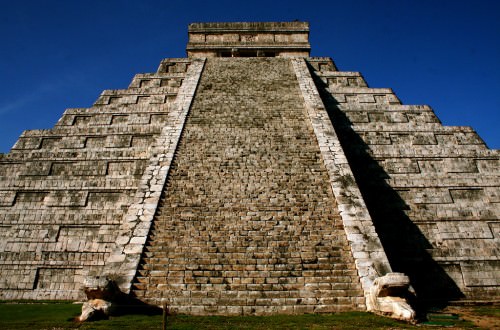
Staircase, Pyramid of Kukulcan, Chichen Itza
In order for the Maya Calendar to be able to accurately predict an end to the world in any way, it would need to begin at the beginning of the world. It is clear from the archaeological, geological, and historical record that the world is much older than the beginning of the Maya Calendar in 3114 BCE. The great cities of Mesopotamia such as Akkad and Eridu had already risen to their height by the time the calendar is dated as beginning. The dynasties of Egypt were already old and the Chinese and Indian civilizations in full flourish. The Maya calculated the date of 3114 BCE as the beginning of the world based upon an earlier calendar by the Mixe-Zoque people. Their forward astronomical predictions were based upon careful observations of the skies but were understood according to the belief system which governed their understanding of how the universe worked and that understanding was that time was cyclical, not linear. Vastly different from the theological and cosmological understanding espoused by the three `great' monotheistic religions, time was, itself, a deity, and, as such, had no end. There is, therefore, nothing in the cosmology of the Maya which suggests an end to anything, much less an end to the world.
MAYA LEGENDS ROUTINELY CONCERN THEMSELVES WITH REGENERATION & TRANSFORMATION.
Maya legends routinely concern themselves with regeneration and transformation. The myth of The Xtabay recounts the lives of Xkeban, the sinner, and Utz-Colel, the virtuous, who transform in death. Xkeban, though considered a sinner for having sex outside of marriage, was more virtuous than the self-righteous and cold Utz-Colel and, when she died, filled the village with sweet perfume and exotic wildflowers known as Xtabentun grew on her grave. Nothing grew on the grave of Utz-Colel but she was transformed into the cactus without scent, the Tzacam, and the flower known as the Xtabay (who also appears as a kind of succubus who waylays unsuspecting traveling men, seduces them, and destroys them). The legend of The Maquech tells the story of the princess Cuzan who falls in love with a man her father does not approve of. A shaman turns Cuzan's lover into an insect which she then keeps with her always. The tale of Nicte Ha follows along the same lines in which the lovers are transformed into a beautiful red bird and a divine lotus which live eternally by the banks of a sacred cenote. The famous Popol Vuh, of course, also follows this same theme. There is nothing in the literature, religion or in the archaeological evidence to suggest that the concept of `endings', as understood in the western, Judeo-Christian tradition, existed in the world of the Maya and there is nothing in the Maya Calendar which supports an interpretation involving the end of the world. As the above epigraph by the Mayanist Gene S. Stuart attests, the Maya believed in “repeating cycles” and their calendar reflects that belief.
To the Maya, time did not travel in a linear movement from the past into the future but was cyclical, as were the lives of their gods (this belief is remarkably similar to that of ancient Mesopotamian culture and other pagan civilizations which followed). In the same way that the gods of the Maya were born, developed and sustained themselves and human life, and then died to be re-born, so the years followed the same course. The Maya Calendar contains two separately working calendars which function simultaneously: the Haab, or civil calendar of 365 days in an 18 month period of 20 days each, and the Tzolkin, or sacred calendar, of 260 days divided into three groups of months of 20 days. The Haab and the Tzolkin work together, like gears interlocking in a machine, to create what is known as the Calendar Round but cannot account for dates farther in the future than 52 days. For longer calculations, the Maya devised what is known as the Long Count Calendar and it is this which has attracted so much international attention in recent years regarding the end of the world on 21 December 2012. The Long Count calendar begins 11 August 3114 and goes into its next cycle (known as a Baktun) on 21 December 2012. This is simply a change in the cycle of the calendar – in the same way that people in the modern age observe the end of a year or the end of a century - and there is nothing in the extant writings of the Maya to suggest that any kind of cataclysm accompanies this transition.
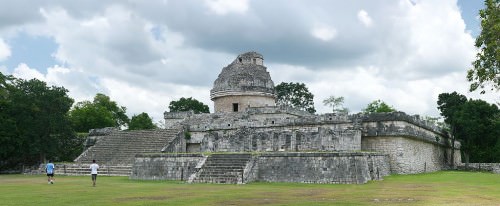
The Caracol, Chichen Itza
On 10 May 2012 CE it was reported that Boston University archaeologist William Saturno and Boston University student Maxwell Chamberlain, excavating at the Maya site of Xultun in Guatemala, discovered a 6x6 foot room dating to 800 CE which seems conclusively to have been a calendar workshop for Mayan scribes. The paintings and inscriptions on the walls of the room show the Mayan calendar extending well beyond the year 2012 CE and that future Baktuns were understood to already be underway in the great cyclic dance of time. According to David Stuart, an expert on Maya hieroglyphs at the University of Texas at Austin, "Baktun 14 was going to be coming, and Baktun 15 and Baktun 16.... The Maya calendar is going to keep going, and keep going for billions, trillions, octillions of years into the future." The months of the years of the Mayan calendars were governed over each by a specific god and, as these gods were eternally recurring, they assured the continuance of the energy of their particular month and, by extension, the years.
THE BACABS REFLECT THE CYCLICAL VISION OF THE MAYA & THE IMPROBABILITY THAT THIS PARTICULAR CULTURE COULD DEVISE A CALENDAR SYSTEM WHICH AIMED AT ANY CERTAIN END OF THE WORLD.
There were four deities in particular, known as The Bearers of the Years (the Bacab) who held the four cardinal points of the sky and imbued a particular year with certain energy. Muluc was the Bacab of the east and his years were always positive in energy. He was associated with the color red. Kan was the Bacab of the south, associated with yellow, and also brought good fortune. Ix, the Bacab of the north was linked with the color white while Cauac, The Bacab of the west's color was black and both of them brought negative energy and bad fortune to the year. The Bearers of the Years changed each year as the dominant deity of that particular cycle of months and stones were very carefully rearranged on the statues in the villages and cities to denote the change. The Bacabs further reflect the cyclical vision of the Maya and the improbability that this particular culture could devise a calendar system which aimed at any certain end of the world.
Western interpretations of the Maya Calendar are just that: western. In such an interpretation time is viewed as linear, not cyclical, and, whether a particular writer adheres to Judaism or Christianity or Islam, they are still prone to view time as it has been understood in the scriptures of those religions. In monotheistic western religions God is intimately involved in the affairs of human beings in a straight chronological line from the creation of the world to the present. In Maya polytheism, the gods created the world and then acted more as guides (and sometimes not very pleasant ones) who performed certain functions in accordance with their particular brand of energy and the energy which ran through a given day or month. `Goodness' was thought to be conserved much in the same way that, in Physics, energy is and the gods granted their goodness to mortals based upon the amount of goodness given to them by human beings. This did not mean, and does not, mean that the gods waited to unleash some final wrath on the world but, rather, that one got what one gave, whether individually or as a community. The relationship between gods and humans was a transfer of energy. The gods were personifications of the planets and of the influences those planets exerted on individuals. Eternity, then, was not a concept involving some future life beyond the earth but was a reality of everyday life for the Maya and they were, and still continue to be, convinced of its continuance on the planet earth.
Interviews conducted by this writer with Maya daykeepers (shamans) at the sites of Chichen Itza and Uxmal revealed that the Maya calendar does not, in any way, predict an `end to the world' but, rather, a new age, a new cycle, in precisely the same way that people in the modern age hope for change and renewal in the new year and make new year's resolutions. If the energy humans send forth toward the gods is good, the energy which returns will be likewise. The end of the Maya Calendar is not an event to be feared but, like any new beginning, is something to be embraced and celebrated as an opportunity to move forward.
LICENSE:
Article based on information obtained from these sources:with permission from the Website Ancient History Encyclopedia
Content is available under License Creative Commons: Attribution-NonCommercial-ShareAlike 3.0 Unported. CC-BY-NC-SA License